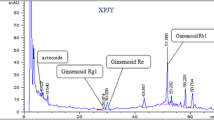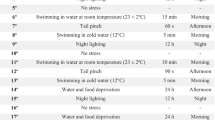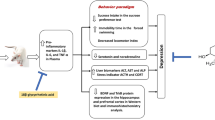Abstract
Depressive state adversely affects the memory functions, especially in the geriatric population. The initial stage of memory deficits associated with depression is particularly called as pseudodementia. It is the starting point of memory disturbance before dementia. The purpose of this research was to study depression and its consequent pseudodementia. For this purpose 24 male albino Wistar rats were divided into four groups. Depression was induced by 14 days of chronic restraint stress (CRS) daily for 4 h. After developing a depression model, pattern separation test was conducted to monitor pseudodementia in rats. Morris water maze test (MWM) was also performed to observe spatial memory. It was observed that model animals displayed impaired pattern separation and spatial memory. Treatment was started after the development of pseudodementia in rats. Curcumin at a dose of 200 mg/kg was given to model rats for one week along with the stress procedure. Following the treatment with curcumin, rats were again subjected to the aforementioned behavioral tests before decapitation. Corticosterone levels, brain derived neurotrophic factor (BDNF) and neurochemical analysis were conducted. Model rats showed depressogenic behavior and impaired memory performance. In addition to this, high corticosterone levels and decreased hippocampal BDNF, 5-HT, dopamine (DA), and acetylcholine (ACh) levels were also observed in depressed animals. These behavioral biochemical and neurochemical changes were effectively restored following treatment with curcumin. Hence, it is suggested from this study that pseudodementia can be reversed unlike true dementia by controlling the factors such as depression which induce memory impairment.












Similar content being viewed by others
References
Afzal A, Ahmad S, Agha F, Batool Z, Tabassum S, Liaquat L et al (2018) Administration of 5-HT-1B agonist ameliorates pseudodementia induced by depression in rats. Pak J Pharm Sci 31:2179–2184
Uchida S, Yamagata H, Seki T, Watanabe Y (2018) Epigenetic mechanisms of major depression: targeting neuronal plasticity. Psychiatry Clin Neurosci 72(4):212–227
Veenit V, Cordero MI, Tzanoulinou S, Sandi C (2013) Increased corticosterone in peripubertal rats leads to long-lasting alterations in social exploration and aggression. Front Behav Neurosci 7:26
Zhao Y, Ma R, Shen J, Su H, Xing D, Du L (2008) A mouse model of depression induced by repeated corticosterone injections. Eur J Pharmacol 581(1–2):113–120
Byers AL, Yaffe K (2011) Depression and risk of developing dementia. Nat Rev Neurol 7(6):323–331
Brommelhoff JA, Gatz M, Johansson B, McArdle JJ, Fratiglioni L, Pedersen NL (2009) Depression as a risk factor or prodromal feature for dementia? Findings in a population-based sample of Swedish twins. Psychol Aging 24(2):373–384
Pozzoli S, De Carlo V, Madonna D (2019) Depression, dementia, and pseudodementia. In: Altamura AC, Brambilla P (eds) Clinical cases in psychiatry: integrating translational neuroscience approaches. Springer, Cham, pp 171–188
Kang H, Zhao F, You L, Giorgetta CDV, Sarkhel S, Prakash R (2014) Pseudo-dementia: a neuropsychological review. Ann Indian Acad Neurol 17(2):147–154
Morimoto SS, Kanellopoulos D, Manning KJ, Alexopoulos GS (2015) Diagnosis and treatment of depression and cognitive impairment in late life. Ann NY Acad Sci 1345(1):36–46
Kennedy J (2015) Depressive pseudodementia how “pseudo” is it really? Old Age Psychiatrist 62:30–37
Neu P, Gooren T, Niebuhr U, Schlattmann P (2019) Cognitive impairment in schizophrenia and depression: a comparison of stability and course. Appl Neuropsychol Adult 26(3):215–228
Belujon P, Grace AA (2017) Dopamine system dysregulation in major depressive disorders. Int J Neuropsychopharmacol 20(12):1036–1046
Nautiyal KM, Hen R (2017) Serotonin receptors in depression: from A to B. F1000Res 6:123
Liu Y, Zhao J, Guo W (2018) Emotional roles of mono-aminergic neurotransmitters in major depressive disorder and anxiety disorders. Front Psychol 9:2201
Kircanski K, Joormann J, Gotlib IH (2012) Cognitive aspects of depression. Wiley Interdiscip Rev Cogn Sci 3(3):301–313
Eisch AJ, Petrik D (2012) Depression and hippocampal neurogenesis: a road to remission? Science 338(6103):72–75
Kosteniuk JG, Morgan DG, O’Connell ME, Crossley M, Kirk A, Stewart NJ et al (2014) Prevalence and covariates of elevated depressive symptoms in rural memory clinic patients with mild cognitive impairment or dementia. Dement Geriatr Cogn Dis Extra 4(2):209–220
Gandy K, Kim S, Sharp C, Dindo L, Maletic-Savatic M, Calarge C (2017) Pattern separation: a potential marker of impaired hippocampal adult neurogenesis in major depressive disorder. Front Neurosci 11:571
Yassa MA, Stark CE (2011) Pattern separation in the hippocampus. Trends Neurosci 34(10):515–525
Phillips C (2017) Brain-derived neurotrophic factor, depression, and physical activity: making the neuroplastic connection. Neural Plast 2017:7260130
Jin Y, Sun LH, Yang W, Cui RJ, Xu SB (2019) The role of BDNF in the neuroimmune axis regulation of mood disorders. Front Neurol 10:515
Stiedl O, Pappa E, Konradsson-Geuken Å, Ögren SO (2015) The role of the serotonin receptor subtypes 5-HT1A and 5-HT7 and its interaction in emotional learning and memory. Front Pharmacol 6:162
Kulkarni SK, Bhutani MK, Bishnoi M (2008) Antidepressant activity of curcumin: involvement of serotonin and dopamine system. Psychopharmacology 201(3):435–442
Choi GY, Kim HB, Hwang ES, Lee S, Kim MJ, Choi JY et al (2017) Curcumin alters neural plasticity and viability of intact hippocampal circuits and attenuates behavioral despair and COX-2 expression in chronically stressed rats. Mediators Inflamm 2017:6280925
Rajasekar N, Dwivedi S, Tota SK, Kamat PK, Hanif K, Nath C et al (2013) Neuroprotective effect of curcumin on okadaic acid induced memory impairment in mice. Eur J Pharmacol 715(1–3):381–394
Sarlak Z, Oryan S, Moghaddasi M (2015) Interaction between the antioxidant activity of curcumin and cholinergic system on memory retention in adult male Wistar rats. Iran J Basic Med Sci 18(4):398–403
Chimakurthy J, Murthy TE (2010) Effect of curcumin on quinpirole induced compulsive checking: An approach to determine the predictive and construct validity of the model. Am J Med Sci 2(2):81–86
Nawaz A, Batool Z, Ahmed S, Khaliq S, Sajid I, Anis L et al (2017) Attenuation of restraint stress-induced behavioral deficits by environmental enrichment in male rats. Pak Vet J 37:435–439
Haider S, Nawaz A, Batool Z, Tabassum S, Perveen T (2019) Alleviation of diazepam-induced conditioned place preference and its withdrawal-associated neurobehavioral deficits following pre-exposure to enriched environment in rats. Physiol Behav 208:112564
van Hagen BT, van Goethem NP, Lagatta DC, Prickaerts J (2015) The object pattern separation (OPS) task: a behavioral paradigm derived from the object recognition task. Behav Brain Res 285:44–52
Haider S, Tabassum S, Perveen T (2016) Scopolamine-induced greater alterations in neurochemical profile and increased oxidative stress demonstrated a better model of dementia: a comparative study. Brain Res Bull 127:234–247
Haider S, Saleem S, Tabassum S, Khaliq S, Shamim S, Batool Z et al (2013) Alteration in plasma corticosterone levels following long term oral administration of lead produces depression like symptoms in rats. Metab Brain Dis 28(1):85–92
De Benedetto GE, Fico D, Pennetta A, Malitesta C, Nicolardi G, Lofrumento DD et al (2014) A rapid and simple method for the determination of 3,4-dihydroxyphenylacetic acid, norepinephrine, dopamine, and serotonin in mouse brain homogenate by HPLC with fluorimetric detection. J Pharm Biomed Anal 98:266–270
Hestrin S (1949) The reaction of acetylcholine and other carboxylic acid derivatives with hydroxylamine, and its analytical application. J Biol Chem 180(1):249–261
Batool Z, Sadir S, Liaquat L, Tabassum S, Madiha S, Rafiq S et al (2016) Repeated administration of almonds increases brain acetylcholine levels and enhances memory function in healthy rats while attenuates memory deficits in animal model of amnesia. Brain Res Bull 120:63–74
Lapmanee S, Charoenphandhu J, Teerapornpuntakit J, Krishnamra N, Charoenphandhu N (2017) Agomelatine, venlafaxine, and running exercise effectively prevent anxiety- and depression-like behaviors and memory impairment in restraint stressed rats. PloS one 12(11):e0187671
Kim MH, Leem YH (2014) Chronic exercise improves repeated restraint stress-induced anxiety and depression through 5HT1A receptor and cAMP signaling in hippocampus. J Exerc Nutrition Biochem 18(1):97–104
Fischer P, Bailer U, Hilger E, Leitner I (2002) Depressive pseudodemenzen (Depressive pseudodementia). Wien Med Wochenschr 152(3–4):62–65
Crowe SF, Hoogenraad K (2000) Differentiation of dementia of the Alzheimer’s type from depression with cognitive impairment on the basis of a cortical versus subcortical pattern of cognitive deficit. Arch Clin Neuropsychol 15(1):9–19
Shelton DJ, Kirwan CB (2013) A possible negative influence of depression on the ability to overcome memory interference. Behav Brain Res 256:20–26
Stephens MA, Wand G (2012) Stress and the HPA axis: role of glucocorticoids in alcohol dependence. Alcohol Res 34(4):468–483
Vollmayr B, Faust H, Lewicka S, Henn FA (2001) Brain-derived-neurotrophic-factor (BDNF) stress response in rats bred for learned helplessness. Mol Psychiatry 6(4):471–474
Lee BH, Kim YK (2010) The roles of BDNF in the pathophysiology of major depression and in antidepressant treatment. Psychiatry Investig 7(4):231–235
Dillon DG, Pizzagalli DA (2018) Mechanisms of memory disruption in depression. Trends Neurosci 41(3):137–149
Miranda M, Morici JF, Zanoni MB, Bekinschtein P (2019) Brain-derived neurotrophic factor: a key molecule for memory in the healthy and the pathological brain. Front Cell Neurosci 13:363
Mizoguchi Y, Yao H, Imamura Y, Hashimoto M, Monji A (2020) Lower brain-derived neurotrophic factor levels are associated with age-related memory impairment in community-dwelling older adults: the Sefuri study. Sci Rep 10(1):1–9
Erickson KI, Miller DL, Roecklein KA (2012) The aging hippocampus: interactions between exercise, depression, and BDNF. Neuroscientist 18(1):82–97
Hei M, Chen P, Wang S, Li X, Xu M, Zhu X et al (2019) Effects of chronic mild stress induced depression on synaptic plasticity in mouse hippocampus. Behav Brain Res 365:26–35
Ruiz N, Del Ángel DS, Olguín HJ, Silva ML (2018) Neuroprogression: the hidden mechanism of depression. Neuropsychiatr Dis Treat 14:2837–2845
Scholl JL, Renner KJ, Forster GL, Tejani-Butt S (2010) Central monoamine levels differ between rat strains used in studies of depressive behavior. Brain Res 1355:41–51
Fink KB, Göthert M (2007) 5-HT receptor regulation of neurotransmitter release. Pharmacol Rev 59(4):360–417
Fernandes SS, Koth AP, Parfitt GM, Cordeiro MF, Peixoto CS, Soubhia A et al (2018) Enhanced cholinergic-tone during the stress induce a depressive-like state in mice. Behav Brain Res 347:17–25
Barry C, Heys JG, Hasselmo ME (2012) Possible role of acetylcholine in regulating spatial novelty effects on theta rhythm and grid cells. Front Neural Circuits 6:5
Liu D, Wang Z, Gao Z, Xie K, Zhang Q, Jiang H et al (2014) Effects of curcumin on learning and memory deficits, BDNF, and ERK protein expression in rats exposed to chronic unpredictable stress. Behav Brain Res 271:116–121
Hurley LL, Akinfiresoye L, Nwulia E, Kamiya A, Kulkarni AA, Tizabi Y (2013) Antidepressant-like effects of curcumin in WKY rat model of depression is associated with an increase in hippocampal BDNF. Behav Brain Res 239:27–30
Xu Y, Ku B, Tie L, Yao H, Jiang W, Ma X et al (2006) Curcumin reverses the effects of chronic stress on behavior, the HPA axis, BDNF expression and phosphorylation of CREB. Brain Res 1122(1):56–64
Lian L, Xu Y, Zhang J, Yu Y, Zhu N, Guan X et al (2018) Antidepressant-like effects of a novel curcumin derivative J147: involvement of 5-HT1A receptor. Neuropharmacology 135:506–513
El Nebrisi EG, Bagdas D, Toma W, Al Samri H, Brodzik A, Alkhlaif Y et al (2018) Curcumin acts as a positive allosteric modulator of α7-nicotinic acetylcholine receptors and reverses nociception in mouse models of inflammatory pain. J Pharmacol Exp Ther 365(1):190–200
Desai A (2016) Dietary polyphenols as potential remedy for dementia. Adv Neurobiol 12:41–56
Akinyemi AJ, Oboh G, Fadaka AO, Olatunji BP, Akomolafe S (2017) Curcumin administration suppress acetylcholinesterase gene expression in cadmium treated rats. Neurotoxicol 62:75–79
Acknowledgements
Authors kindly acknowledge the Higher Education Commission (HEC), Pakistan, for Funding the project NRPU-3766.
Funding
This study was funded by Higher Education Commission (HEC), Pakistan (project NRPU-3766) received by S. Haider. The funders had no role in study design, data collection and analysis, decision to publish, or preparation of the manuscript.
Author information
Authors and Affiliations
Corresponding author
Ethics declarations
Conflict of interest
All authors declare no conflict of interest.
Additional information
Publisher’s Note
Springer Nature remains neutral with regard to jurisdictional claims in published maps and institutional affiliations.
Rights and permissions
About this article
Cite this article
Afzal, A., Batool, Z., Sadir, S. et al. Therapeutic Potential of Curcumin in Reversing the Depression and Associated Pseudodementia via Modulating Stress Hormone, Hippocampal Neurotransmitters, and BDNF Levels in Rats. Neurochem Res 46, 3273–3285 (2021). https://doi.org/10.1007/s11064-021-03430-x
Received:
Revised:
Accepted:
Published:
Issue Date:
DOI: https://doi.org/10.1007/s11064-021-03430-x




